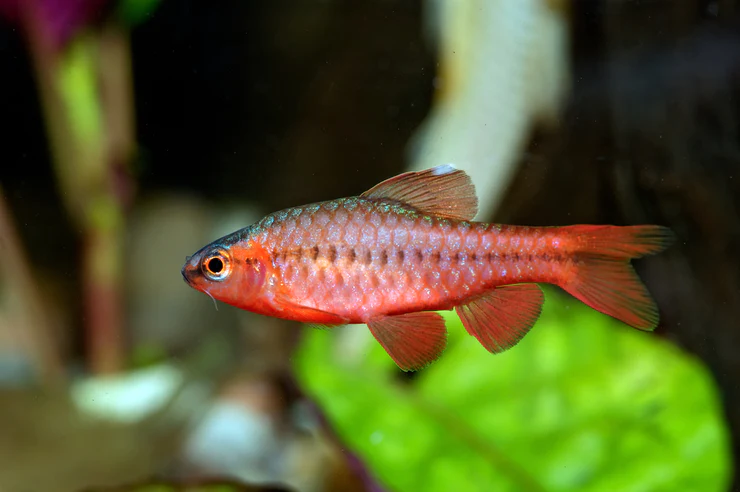
Size
1.5 to 2 inches
Physical Characteristics
The cherry barb has a tiny, elongated body that is somewhat compressed. The female’s top is fawn in hue with a somewhat greenish gloss. Shiny silver highlights can be seen on its tummy and sides. On its back and top sides, it could have a rosy tone. From the tip of the snout, past the eye, and to the base of the caudal fin, there is a horizontal stripe. The male has a more slender body form and a reddish tint that turns quite deep red after breeding.
Temperament
Although these fish are generally calm, during the spawning season the males grow more hostile. By making sure that the tank is well-planted, that there are lots of caves, and that a good ratio between males and females is maintained, this antagonism can be lessened.
Habitat
It is indigenous to Sri Lanka, and populations that were brought there have settled in Mexico and Colombia. An area of calm, shallow water that receives a lot of shade is the cherry barb’s native environment. Its natural base is silty and covered in leaves.
Keeping as Pet

- Tank Size
A tank with a small school of fish in it, between 25 and 30 gallons, is the Cherry Barbs optimum habitat. Dark gravel placed over dark sand will resemble a natural substrate. Cherry Barbs love to stay towards the tank’s bottom for the majority of the time.
- Water Parameters
The Cherry Barb needs water that is between 71 and 82 degrees Fahrenheit in temperature, and its pH should be between 6.5 and 7.5. Bogwood or peat moss will aid in maintaining a low pH. The water should range in hardness from very mild to very hard, or 5 to 19 dH.
- Feeding
A balanced diet for cherry barbs should include a variety of frozen, live, and freeze-fried foods. Regular offerings of worms, brine shrimp, and insect larvae should be made, including cut-up earthworms, bloodworms, and Tubifex worms. Having a consistent supply of live foods, however, can be costly and unsafe.
- Tank mates
The most common fish to pair with cherry barbs may be tetras because many varieties are equally vibrant, serene, and energetic in a school. Neon tetras, black skirt tetras, rummy nose tetras, emperor tetras, and lemon tetras are some of the best tetra species that are compatible with cherry barbs.
Table





